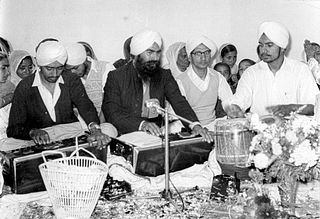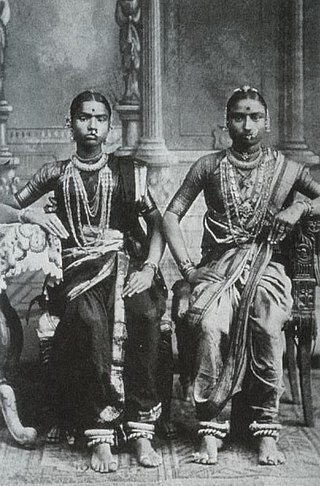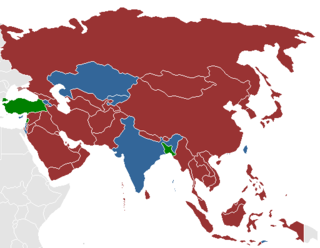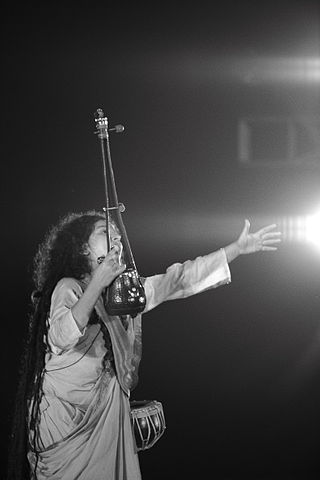Sukumari Dutta or Golap Sundari was an Indian theater actress, manager and playwright. She was also known as a kirtan singer.
Sukumari Dutta or Golap Sundari was an Indian theater actress, manager and playwright. She was also known as a kirtan singer.

Dutta’s mother brought her to Calcutta in order to be trained as a vaishnav singer. She would later be described as remarkable singer and dancer. [1] She became one of the first four women hired to be an actress by the Bengal Theater. [2] This theater was noted for being the first public theater to employ actresses to act in female roles instead of male actors impersonating women. [1] She later adopted the name Sukumari after she successfully played the heroine in Upendranath Das’s Sarat-Sarojini, which was performed at the Great National Theater on January 2, 1875. [1] It was the name of her character in the play. [3]
In a published biographical sketch, Dutta is said to have married Goshtobihari Dutta, [1] a respectable and middle class husband from Bengal. [4] [5] This was an arranged marriage made under the Native Marriage Act III of 1872, which allowed mixed-caste and mixed-faith marriages in India. [1] Goshtobihari also acted in Das’s Sarat-Sarojini. [6] Dutta retired from acting after their marriage. [7] During her time, actresses were ostracized because they were also considered prostitutes. [1] Goshtobihari, however, deserted her, prompting Dutta to come back to theatrical performance. It is said that he followed Das in England after the latter fled India due to his anti-Raj sentiments. [1] Dutta was left to raise their daughter.
Dutta’s career highlights included performances for the roles, Bimala in Durgeshnandini, Rani Oilobala in Purubikram, Birajmohini in Surendra-Binodini, Girijaya in Mrinalini, Malina in Asrumati, and Surjamukhi in Bishbriksha. [3]
She was also identified as a kirtan singer. Kirtan is a form of singing where marginalized women sing religious songs. [4] She also managed the all-women “Hindoo Female Theater”, which was active during the early 1880s. [1] She also co-wrote the play, Apurba Sati Natak (The Unvanquished Chaste Maid), which was published in 1876 and performed at the Great National on August 23, 1876. [1] This play, which is about the tragedy of a prostitute’s daughter, is said to be a mirror of the author’s life, particularly her marriage to someone who belong to a different social class. [2]

Sarojini Naidu was an Indian political activist and poet who served as the first Governor of United Provinces, after India's independence. She played an important role in the Indian independence movement against the British Raj. She was the first indian woman to be president of the Indian National Congress and appointed as governor of a state.

Kirtana, also rendered as Kirtan or Keertan, is a Sanskrit word that means "narrating, reciting, telling, describing" of an idea or story, specifically in Indian religions. It also refers to a genre of religious performance arts, connoting a musical form of narration or shared recitation, particularly of spiritual or religious ideas, native to the Indian subcontinent. A person performing kirtan is known as a kirtankara.

In India, a devadasi is a female artist who is dedicated to the worship and service of a deity or a temple for the rest of her life. The dedication takes place in a ceremony that is somewhat similar to a marriage ceremony. In addition to taking care of the temple and performing rituals, these women also learn and practice classical Indian dances such as Bharatanatyam, Mohiniyattam, Kuchipudi, and Odissi. Their status as dancers, musicians and consorts were an essential part of temple worship.

Bethune College is a women's college located on Bidhan Sarani in Kolkata, India, and affiliated to the University of Calcutta. It is the oldest women's college in India. It was established as a girls' school in 1849, and as a college in 1879.

The music of West Bengal includes multiple indigenous musical genres such as Baul, Ramprasadi, Bishnupuri Classical, Kirtan, Shyama Sangeet, Rabindra Sangeet, Nazrul Geeti, Dwijendrageeti, Prabhat Samgiita, Agamani-Vijaya, Patua Sangeet, Gambhira, Bhatiali, Bhawaiya, Bengali Rock.
Das is a common last name in South Asia, among adherents of Hinduism and Sikhism, as well as those who converted to Islam or Christianity. It is a derived from the Sanskrit word Dasa meaning servant, devotee, or votary. "Das" may be inferred to be one who has surrendered to God. The surname is often used by those in the Vaishnav community.

Prostitution is legal in India, but a number of related activities including soliciting, kerb crawling, owning or managing a brothel, prostitution in a hotel, child prostitution, pimping and pandering are illegal. There are, however, many brothels illegally operating in Indian cities including Mumbai, Delhi, Kolkata, Pune, and Nagpur, among others. UNAIDS estimate there were 657,829 prostitutes in the country as of 2016. Other unofficial estimates have calculated India has roughly 3–10 million prostitutes. India is widely regarded as having one of the world's largest commercial sex industry. It has emerged as a global hub of sex tourism, attracting sex tourists from wealthy countries. The sex industry in India is a multi-billion dollar one, and one of the fastest growing.

Tista Das or Teesta Das is an Indian transgender rights activist, actress and writer from the Indian state of West Bengal. She has acted in several Hindi and Bengali films.
Dutta, also spelled Datta, is an Indian family name Its variation is Dutt.
Manikuntala Sen was one of the first women to be active in the Communist Party of India. She is best known for her Bengali-language memoir Shediner Kotha, in which she describes her experiences as a woman activist during some of the most turbulent times in India's history.

Roopa Ganguly is an Indian actress, playback singer and politician. She is best known for her portrayal of Draupadi in B R Chopra's hit television series Mahabharat. Often promoted as the Tollywood's answer to Bollywood's Shabana Azmi, she is known for her versatility and accent adaptation. She has worked with directors such as Mrinal Sen, Aparna Sen, Goutam Ghose and Rituparno Ghosh. She is a trained Rabindra Sangeet vocalist and a classical dancer. She received several awards including a National Award and two BFJA Awards. In October 2016, she was nominated as a Member of Parliament, Rajya Sabha, by the President of India. She served as the President of BJP Mahila Morcha in West Bengal. She served as the General Secretary and the Vice-President for the West Bengal Motion Picture Artistes' Forum, a body representing cine artistes. Her films have commulatively grossed more than US$100 million worldwide.
Sarah Begum Kabori was a Bangladeshi film actress and politician. Her notable films include Sutorang, Sareng Bou, Abhirbhab, Shat Bhai Champa, Sujon Sokhi and Lalon Fokir. She received the Bangladesh National Film Award for Best Actress for her role in the film Sareng Bou (1978) and Lifetime Achievement Award in 2013.

Parvathy Baul is a Baul folk singer, musician and storyteller from Bengal and one of the leading Baul musicians in India. Trained under Baul gurus, Sanatan Das Baul, Shashanko Goshai Baul in Bengal, she has been performing both in India and other countries since 1995.

Dr Phulrenu Guha was an Indian activist, educationist and politician, belonging to the Indian National Congress. She was a member of the Rajya Sabha the Upper house of Indian Parliament from April 1964 to April 1970 from West Bengal. She was the Minister for Social Welfare in the Indira Gandhi Ministry from 1967 to 1969. She was elected to the Lok Sabha the Lower house of Indian Parliament from Contai constituency, West Bengal in 1984. She was awarded the Padma Bhushan in 1977.
Suhasini Chattopadhyay was an Indian communist leader and a freedom fighter. She was the first woman member of the Communist Party of India.
Basanti Devi was an Indian independence activist during the British rule in India. She was the wife of activist Chittaranjan Das. After Das' arrest in 1921 and death in 1925, she took an active part in various political and social movements and continued with social work post-independence. She was awarded the Padma Vibhushan in 1973.

The Indian independence movement was a series of historic events with the ultimate aim of ending British rule in India, lasting from 1857 to 1947. Women played a pivotal role in achieving India's independence. However, their lives, struggles, and contributions to the movement are never recognized at the same level of prominence as that of the men of the movement. Additionally, their names are seldom heard when discussing the independence movement, or mentioned in brief. Woman’s participation in India’s freedom struggle started as early as 1817. Bhima Bai Holkar fought against the British Colonel Malcolm and defeated him in guerrilla warfare. Throughout the twentieth century, numerous women continued to contribute to the movement through military leadership, political leadership, and social activism.
Sarala Roy (1861-1946) was an Indian educator, feminist, and social activist. She was one of the first women to matriculate from Calcutta University, and was the first woman to be a member of the University Senate. She founded a school for girls and several women's educational charities, and was a founding member and later, the President of the All India Women's Conference. As President of the All India Women's Conference in 1932, she played a key role in organizing efforts towards women's suffrage, and against child marriage. She was also a strong supporter of educational rights for women and girls.
The Chhatri Sangha was an Indian women's student organization. It recruited and trained women revolutionaries, organized study circles and gave lessons in cycling, driving and armed warfare. It functioned as the girls' faction of the All India Students' Federation.

Annapurna Dutta was one of the early female professional photographers from India. At a time when studio-photography was a male-dominated profession, and accepting employment outside the domestic home was uncommon for women, Annapurna gained popularity as "Photographer Mashima" amidst her younger contemporaries. She did not own a studio, but instead worked on a commission-basis, visiting people's homes to click portraits. Most of these commissions came from families where women observed a purdah. She also developed and printed the pictures herself.